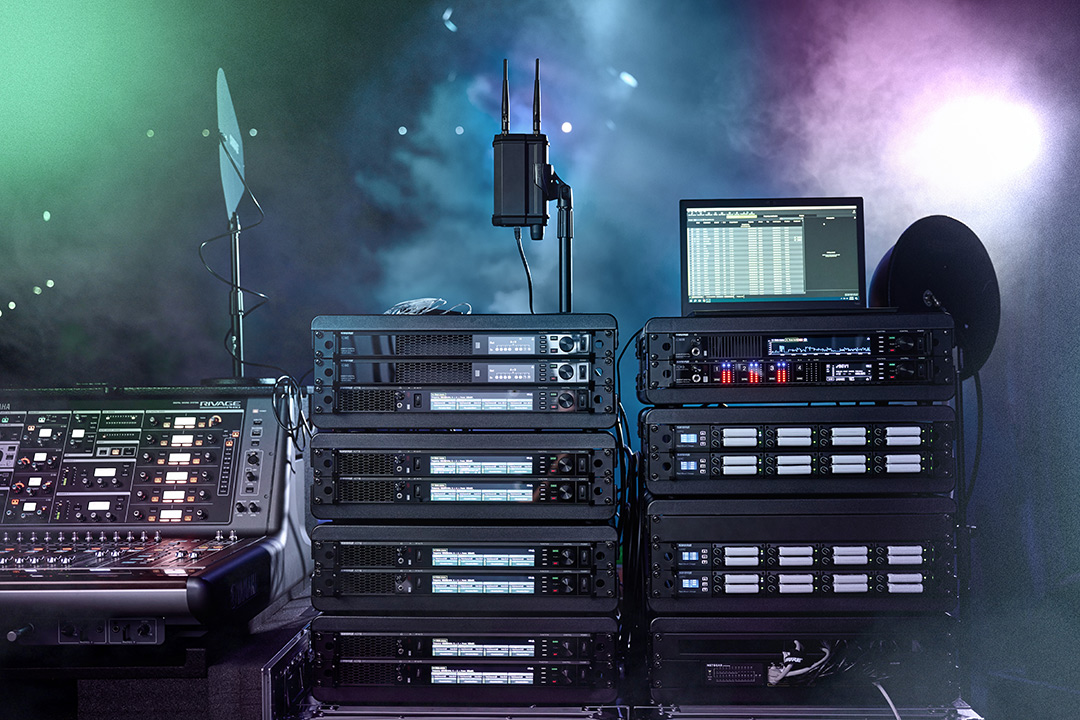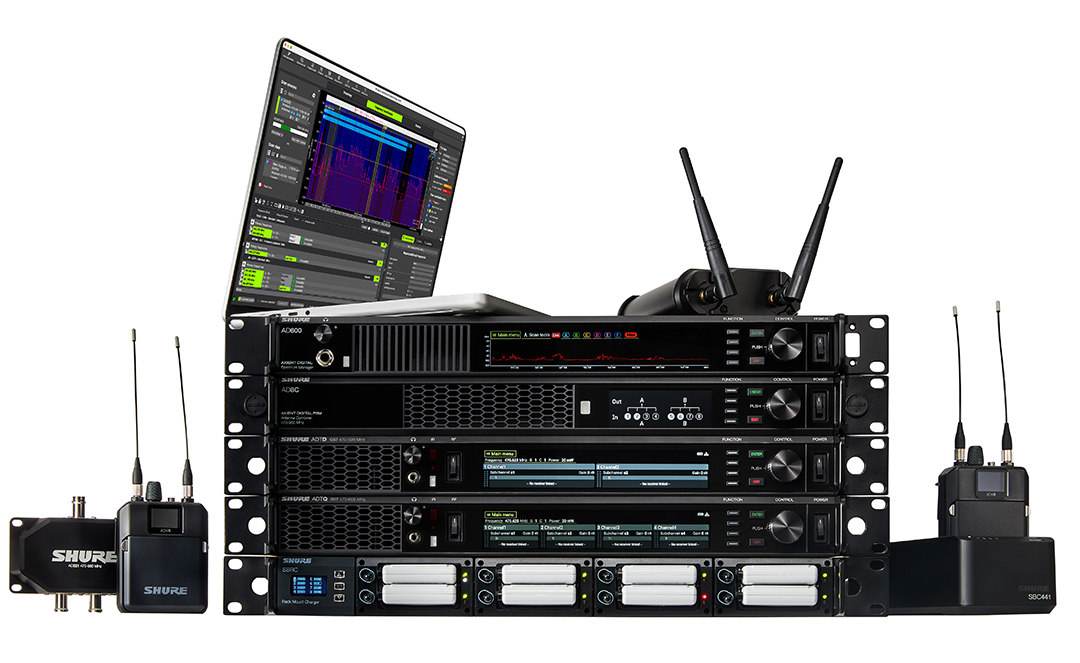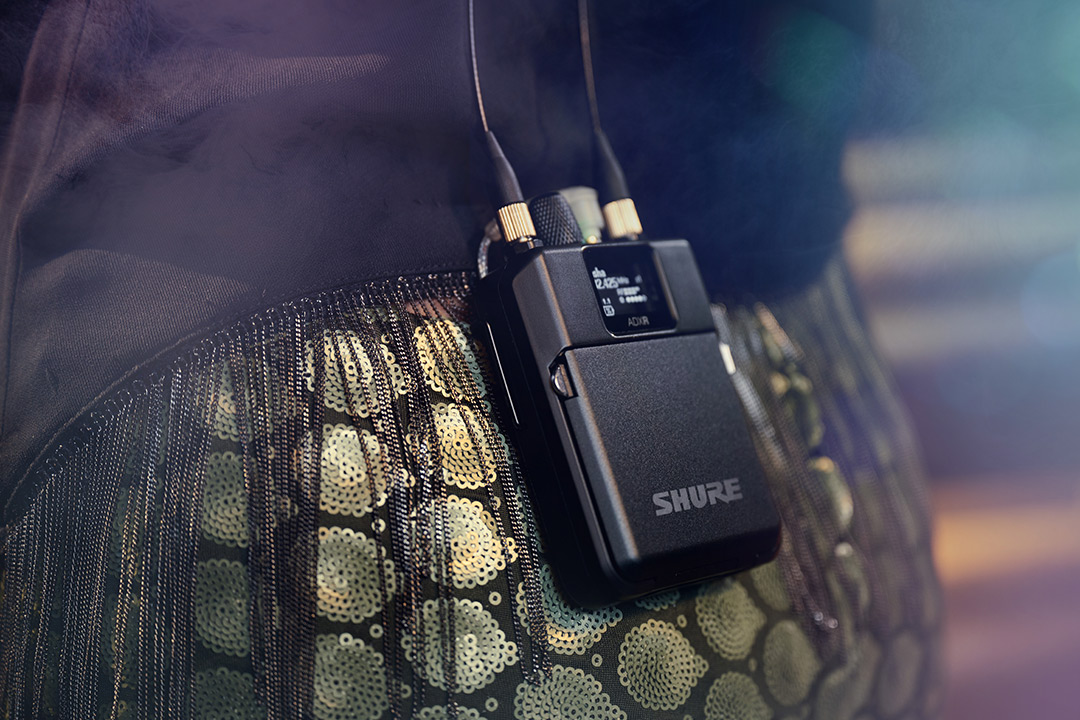The first Shure system to take advantage of the new Wireless Multichannel Audio Systems (WMAS) regulatory framework is the AXIENT DIGITAL PSM in-ear monitoring system.
As we discussed in a previous article, Shure played an important role in defining and adapting the new WMAS regulatory framework, which now allows this technology to be used in touring and professional productions.

With the Axient Digital PSM, Shure offers a new solution that transcends the quality of in-ear monitoring, extends the RF spectrum capabilities of transmission and makes it easier to implement, all while maintaining compatibility with existing systems. It’s a smart, pragmatic choice that ensures sound engineers, RF technicians and equipment vendors can continue to use their equipment while benefiting from the most advanced technology in wireless systems.
Today’s increasingly large-format entertainment industry demands ever more ambitious wireless environments. By integrating its WMAS vision into the Axient Digital PSM, while maintaining a traditional narrowband transmission option, Shure gives professionals the technical means to adapt to any type of environment, from the simplest standard configuration of a few IEM radio links to the most complex solution necessitated by a restrictive RF environment.

This approach, which consists of maintaining both types of transmission in the same device, allows perfect versatility and offers total security to the sound company, who is thus free to opt for the most appropriate technology. In the same way, a digital in-ear system gives access to sound quality hitherto unmatched in IEMs, while maintaining latency levels acceptable to musicians and artists.
“For nearly a century, we at Shure have been creating innovative solutions with a focus on solving customers’ problems, while driving advancements in the live and entertainment industry,” said Nick Wood, Senior Director of Global Marketing and Product Management for Shure.
“WMAS innovations, remote management, impeccable audio quality… Working alongside artists and sound engineers for decades, we are more committed than ever to promoting spectral efficiency and WMAS regulations throughout the world to support the dynamism of the cultural sectors.
“Our new Axient Digital PSM system embodies this commitment and marks a decisive turning point, offering users even more resources to optimise their performance and ensure the most efficient use of the spectrum, now and in the future.”

When operated in WMAS mode, the Axient Digital PSM can handle up to 40 wireless transmission channels in each 8 MHz band. It uses traditional Shure coaxial antenna systems with proprietary Spatial Diversity technology on two antennas, providing a simpler solution for supporting individual areas and optimising coverage in large spaces such as stadiums or festivals. AES256 encryption ensures secure transmission.

The Axient Digital PSM transmitters support both analogue and digital input formats, including AES3, Dante and AES67, to facilitate connection to mixing consoles. The rear panel features four or eight (depending on model) combo connectors that are switchable between analogue or AES3 digital, as well as four Ethernet ports for network control and Dante/AES67 digital input options.
A headphone output with adjustable volume is available on the front panel and two coaxial antenna output connectors complete the rear panel. Importantly, the Axient Digital PSM system is fully compatible with the Shure RF environment, allowing it to be remotely controlled via ShowLink, and managed by Wireless Workbench software (which we’ll cover in more detail in a future article). Axient Digital PSM offers two models of rack-mounted transmitters: the quad ADTQ and the dual ADTD.

The system is completed by the addition of the ADXR body pack receivers. This new receiver, designed to drive in-ear headphones, incorporates patent-pending automatic impedance detection, enabling it to optimise audio performance and battery life according to the earphones connected to it.
Its CueMode function lets you memorise up to 64 separate channels on a single unit. It is lightweight, rugged and moisture-resistant, with hybrid aluminium/polymer construction.
The defining feature of the Axient Digital PSM system is its four transmission modes. This makes it a flexible and powerful solution, capable of meeting any requirements of today’s show formats.
– Multi-channel Wideband mode takes advantage of the wide bandwidth permitted by the WMAS regulatory framework, allowing up to 40 channels for each 8 MHz band (in Europe).
– Narrowband mode provides more RF transmission power per channel and maintains bandwidth efficiency, at 23 channels per 8 MHz band.
– Analog FM mode delivers excellent audio quality with extremely low latency.
– And Axient Digital Standard mode (point-to-point mode) enables long-distance audio transmission to any Axient Digital receiver. This mode will be introduced in a future firmware update.
Axient Digital PSM is supported by the Shure Wireless Workbench and ShowLink software ecosystems. Monitor engineers have comprehensively remote control and monitoring of each receiver on stage, with a clear overview of key parameters and the ability to adjust if necessary.
ShowLink provides real-time control and continuous monitoring of all receivers, including connection quality, battery life, volume, headphone connection status, etc. With Wireless Workbench and the AD600 Spectrum Manager, technicians can troubleshoot problems, monitor the RF spectrum and maintain backup frequencies, ensuring smooth performance throughout the show.

The new WMAS technology can be exploited in many ways and every wireless manufacturer will have a different approach. Shure’s vision is extremely clever. It takes advantage of the many audio and RF spectrum benefits of this technology, while maintaining a high level of compatibility with Shure’s existing equipment and the current operating methods of wireless users.
We spoke with Tuomo Tolonen, Senior Director of Strategic Global Market Development for Shure, who explained the many benefits of this approach.
SLU : Good morning, Tuomo, can you tell us a bit more about your work at Shure?
Tuomo Tolonen : I have been working with Shure for over 18 years. I have a technical background and extensive wireless experience. I spent a lot of time in the field deploying systems when everything was analogue. The number of channels was much smaller than it is now, and general knowledge of radio technology was rather sketchy.
My current role is to gather information from our users, in all kinds of fields, and then analyse these issues with our development team so that we can continue to develop incredibly effective products. I work closely with Prakash Moorut and the regulatory team. I’ve been involved in regulatory discussions in the UK for about 17 years and I know enough about spectrum availability issues to understand why a product like the Axient Digital PSM now merits existence.

SLU : Do you see this new technology as an essential solution to the shortage of frequencies?
Tuomo Tolonen : Let’s take a brief look at what happened. In the 70s and 80s, wireless microphones were mainly used by high-end touring acts, for television and in musicals. They were very expensive, quite bulky and of mediocre reliability.
In the early 2000s, the use of wireless technology evolved enormously. It was at this point that wireless microphones both got better and became more affordable, so that they began to be used not only by high-level users but also by those in between, in all kinds of venues and applications.
Then the arrival of the iPhone and smartphones changed all that. Mobile phones no longer just needed a telephone connection, they also needed a data connection, to be able to read emails, surf the Internet and watch videos. The cellular industry therefore began lobbying frequency regulators hard to meet the growing demands of their market.
Our industry, which used to share the UHF bands with only terrestrial broadcast television, found itself confronted with this new presence of mobile operators, who also wanted to get their hands on the UHF bands, the wavelength of which provides very favourable transmission range. Access to the UHF spectrum for wireless operators therefore began to be limited, in favour of the frequencies conquered by mobile operators. Since 2012, almost 50% of this spectrum has been handed over to mobile telephones. We have lost access to the 800 MHz band, then the 700 MHz band.
At the same time, all the terrestrial television that existed in the 700 and 800 MHz band has been concentrated into the remaining spectrum between 470 and 694 MHz, so the scenario is always the same: television takes priority, and wireless mics and IEMs are always secondary. Fortunately, we can continue to coexist using what we call the white spaces of the free spectrum, but these are now much more restricted.
SLU : So, it was necessary to act at the international regulatory level to develop a new transmission method tailored to these constraints?
Tuomo Tolonen : The industry moved from analogue to digital wireless microphones but continued to use narrowband RF transmission (200 kHz), imposed by ETSI, the organisation that defines technological standards for communications. This posed challenges in terms of meeting the high quality demanded by our users, whether for musical theatre, television, or performing artists.
From an engineering point of view, it was becoming increasingly difficult to maintain high audio quality for wireless mics within the restricted bandwidth of 200 MHz, much less produce quality stereo for IEMs. That’s where we joined forces with other manufacturers to establish a new standard, which is now referred to as WMAS.
SLU : Could you tell us what WMAS is?
Tuomo Tolonen : The framework offered by WMAS is the next step in digital transmission techniques. It uses a carrier with a much wider bandwidth than we are used to in narrowband. It essentially defines three minimum performance criteria: the bandwidth of the carrier, its maximum output power and the spectral mask, i.e. a transmission mask that essentially indicates the amount of noise allowed outside the primary carrier.
These rules are much more attractive to use than the narrow band we are familiar with, which imposes several compromises on autonomy, audio quality and digital latency plus physical constraints linked to the use of energy. It is important to understand that the WMAS defines how manufacturers must transmit data in frequency space, but in no way defines how the transmitted data is formatted. The technical approach to the data transmitted in WMAS is entirely up to the manufacturer.
SLU : WMAS is also a response to the shortage of spectrum availability you just explained?
Tuomo Tolonen : Exactly. One of the reasons for introducing the WMAS standard was to allow even greater spectral efficiency, i.e. the ability to obtain even more channels in a limited proportion of the RF spectrum. After that, it’s up to the manufacturer to choose how to do it. This is the beginning of a period of development that I find very interesting.
SLU : For its first WMAS product, Shure seems to have adopted a unique approach by offering a product dedicated solely to IEMs, no?
Tuomo Tolonen : : It was obvious to us. I’ve spent the last 18 years talking to our users. In 2011, with our PSM 1000 wireless IEM system, we created an industry standard, but one that uses analogue FM technology.
The question I’ve been asked time and time again by monitor engineers over the last ten years, since the release of our first digital system product ULX D in 2012 and then Axient Digital in 2017, has always been the same: When will your wireless IEM systems go digital? Well, now!

SLU : Does your new Axient Digital PSM system, using WMAS, eliminate all the current limitations of wireless IEMs?
Tuomo Tolonen : The analogue FM we talked about earlier suffers from audio limitations on wireless IEMs. The frequency response that the analogue FM carrier imposes doesn’t allow for good transmission of low frequencies and limits the top end of the audio spectrum to around 15 kHz.
It is also impossible to obtain a true stereo carrier, and it takes a lot of RF magic to get the brain to perceive stereo with a single 200 kHz carrier. The solution would have been to have two receivers, one for each channel, but you must admit that’s not practical. The other major limitation was of course the RF bandwidth, which limited the choice of frequencies.
So, there was a clear need for a digital system to solve all these problems and offer IEMs for live performers as well as IFBs for TV broadcasts, with digital quality and remote control in a broadband system capable of working anywhere in the UHF bands. The approval of WMAS by the international regulatory bodies has enabled us to finalise this product, which we have been developing for over three years, and which perfectly reflects market demand.

SLU : WMAS provides bi-directional links. Is there demand for a transmitter body pack that can manage both an IEM and a microphone or line input?
Tuomo Tolonen : Yes, I think we could one day make a bidirectional box because WMAS makes it easier to manufacture. But the transceiver concept is not new. It has already existed for specific applications. Shure already made some in 2018 with the Microflex Complete Wireless conferencing system, which is based on two-way conference sets. The return channel was sometimes used for translation purposes. Other manufacturers also offer them.
As it stands now, I don’t think that a transceiver for musical performances is necessarily the way forward. What’s more, imagine a musician changing instruments during a show. The operation might be more complex with two-way units than with IEMs and wireless microphones on separate body packs.
SLU : Does Shure have a particular approach to maximising bandwidth in WMAS?
Tuomo Tolonen : In this product, Shure has chosen to use an 800 kHz broadband carrier that supports four sub-users, or sub-carriers. We think this approach is more RF friendly because it makes it easier to find spectrum to use. RF environments are incredibly crowded. Whether you’re at a festival or in the middle of Paris in a theatre, between the TV channels and the other wireless users, being able to always find a completely empty 8 MHz channel, regardless of the number of wireless links in use, seems rather tricky.
SLU : Doesn’t this limit the number of RF channels you can deploy?
Tuomo Tolonen : No, quite the contrary. By favouring an 800 kHz carrier approach, it is easier to deploy several sub-carriers. With the Quad version of the Axient Digital PSM, you can handle four RF channels with four stereo IEM links each, so a total of 16 stereo IEMs (or 32 mono IFBs for TV) in just 3.2 MHz of bandwidth (4 × 800 MHz).
So in the total authorised WMAS bandwidth of 8 MHz, we can operate 40 stereo IEMs. We still achieve the promise of greater spectral efficiency but have total freedom to achieve it by deploying a multitude of 800 kHz carriers across the RF spectrum, even in the most challenging RF environments.
SLU : Is the audio on the links configurable?
Tuomo Tolonen : We don’t offer any options for adjusting the audio parameters in the WMAS transmission mode. We don’t compromise on audio quality. We have chosen to offer the best possible sound with a fixed latency of 2.9 ms.
As we have seen, this gives us 40 stereo links in an 8 MHz bandwidth. This approach is perfectly suited to what WMAS was designed to achieve: maximum spectrum efficiency with many channels. It is then easy to increase the number of channels while maintaining reliability and uncompromised audio quality, even in the most challenging RF environment.

So we can go to the Super Bowl, which is a nightmare, and find small open spaces in the spectrum to accommodate our radio links. Trying to find a full TV channel everywhere is, in our opinion, impractical. That’s the whole point of the WMAS standard. It doesn’t dictate a fixed carrier bandwidth.
It simply says that we are no longer limited by a 200 kHz carrier and leaves us free to use it as we wish. Our approach is user-friendly and respectful of the RF environment, so we can provide a greater number of radio links.
SLU : On the other hand, the RF channels of the Axient Digital PSM are configurable and offer several transmission modes, including narrowband?
Tuomo Tolonen : Yes, it offers a total of four transmission modes. In addition to the WMAS digital broadband we just discussed, there are three types of narrowband transmission. The first is traditional analogue FM. Why? Because this mode is compatible with the existing PSM 1000 receivers, in which hundreds of rental companies and services have already invested heavily. They can therefore use them, and this entirely analogue mode obviously delivers the lowest possible latency.
There is also a narrowband digital mode, which is like Axient Digital, but with a bandwidth of 200 kHz. This mode offers high spectrum efficiency. In 8 MHz, we can fit 23 carriers, each with a bandwidth of 200 kHz. Having 23 stereo IEMs in an 8 MHz band is brilliant, and many users continue to use this transmission mode because they are familiar with it. The third “point-to-point” mode allows a transmitter to talk directly to a digital receiver.
This mode is used for transmission over longer distances, to send a stereo mix to other units very far away, or to feed, for example, PA delay lines. This makes the Axient Digital PSM extremely flexible. It’s easily adaptable and works in both difficult and less challenging environments. You can use analogue FM, digital narrow band or digital wide band to get the most out of your environment, avoiding the use of a single 8 MHz carrier in every location.
SLU : So the Axient Digital PSM can be used to create a wide variety of configurations?
Tuomo Tolonen : With our technical approach, there are other advantages in addition to broadband, and one of them is scalability in terms of the use of the device’s resources. If you take a traditional piece of equipment like the PSM 1000, it’s a two-channel transmitter. If I don’t use channel 2, the resources of channel 2 are lost. With the Axient Digital PSM, it’s different. We have resources for the whole device that can be allocated quite freely between the channels.
In the Quad transmitter model, we therefore have four integrated WMAS radio channels (two for the Dual model) that we can configure to manage the number of channels, the transmission mode and the RF output power, as required. It’s an ideal system for wireless users because they can use it as they wish. The Quad model can be configured in a multitude of ways to manage from four up to a maximum of 16 stereo RF links, and from two up to eight for the Dual model, depending on the requirements. This will greatly simplify the problems faced by sound services, who will be able to manage all types of IEM configurations using the same device.
SLU : Does this have an impact on the use of the system’s transmitting power?
Tuomo Tolonen : Yes, of course. In WMAS, the RF power of the carrier is shared equally between the subcarriers. In our case, with a 50 mW 800 kHz bandwidth carrier, this means that each of our four subcarriers has 12.5 mW of power. If you have a single carrier with a very large bandwidth of 8 MHz at 50 mW with 32 subcarriers, the distributed power will become extremely low, which means that more antennas will have to be used, or they will have to be closer together.
SLU : As far as antennas are concerned, are you maintaining the traditional coaxial type?
Tuomo Tolonen : We chose to retain traditional antenna technology, to maintain the ability to work alongside other existing infrastructures, such as the Wisycom fibre solutions that are routinely used at major events to extend the range. If you take Taylor Swift’s tour or other shows of the same format, the stage is huge and the artist runs from the main stage to the B stage and sometimes into the crowd. Her IEM will need to work all the time.
And the show depends on them working properly because they contain all the signals for the show: cues, clicks, etc., but also for health and safety. The coverage has to work continuously, and, in my opinion, this is still much easier to achieve with traditional antennas. And as these new systems must coexist with other existing equipment, they have to be compatible with the existing antenna infrastructure.
SLU : Getting back to latency… isn’t 2.9 ms too much for musicians’ IEMs?
Tuomo Tolonen : We believe that 2.9 milliseconds for a stereo IEM with high-quality audio is a totally acceptable value. It will be increased slightly by the other equipment in the signal chain, but it remains the best compromise. However, if for an artist, engineer or anyone else thinks that latency is non-negotiable and that this value seems too high, there is still the option of transmitting with the same device in analogue FM, and therefore with zero latency. This is one of the main reasons we have retained this transmission mode. You’ll miss out on some of the performance associated with digital, but you’ll still be able to meet any demand.
We could reduce this latency in digital, but at the expense of the number of possible channels. We have chosen a level of latency that we believe is suitable for 95% of our users, to provide excellent audio quality and the benefit of the full spectrum efficiency of WMAS. Could we see other transmission modes in the future? Yes, perhaps. The underlying technology gives us plenty of room for development and you’ll see new features appearing rapidly.
SLU : So, the system incorporates a wide range of remote-control options for the receivers?
Tuomo Tolonen : Real-time remote control of wireless systems is nothing new at Shure. ShowLink was introduced as part of the very first Axient system in 2012! Of course, it can be used on this system and is independent of WMAS technology. Seeing the receiver information on the transmitter front panel or in Wireless Workbench is a clear advantage. We also offer headphone impedance management, because the body packs are designed to power a wide range of in-ear headphones.

SLU : Is the system compatible with WorkBench?
Tuomo Tolonen : Of course it is. This software enables remote control of transmitters or receivers. It also offers radio interference detection and avoidance capabilities, by automatically changing the transmission frequency. This option will not be available immediately upon product launch but is one of the features that will be added in the future. In WMAS, I don’t have to change a narrowband carrier, I must change a wideband carrier. While it’s very easy to change a 200 kHz carrier almost instantly, it’s a more complex task for an 800 kHz carrier.
This is one of the reasons why we opt to use a restricted bandwidth, because if it were very wide and included a lot of sub-carriers, the time needed to move it would become difficult to manage in a live performance. At present, it is possible to change the frequency manually in the event of a problem. With our bandwidth restricted to 800 kHz, we estimate that we will be able to change the frequency in less than 50 milliseconds, and that it will be easier to find available frequency space.
SLU : Are we going to see a flood of new WMAS systems?
Tuomo Tolonen : The WMAS regulations are so easy to implement that we are likely to see the emergence of new manufacturers of wireless systems. Will they offer top-quality wireless products that rival those of the market-leading brands? Probably not, because many other criteria, such as audio quality and transducers, are more difficult to meet.
SLU : Could we see even more affordable WMAS systems?
Tuomo Tolonen : I think that, within five to ten years, we’ll see systems at lower prices for other industries and other markets, and certainly for the MI market. It will be extremely popular to offer four or eight channels of high-quality wireless links to groups of musicians, which can be operated instantly without the need for frequency intervention.
The WMAS regulatory framework offers an extremely broad and promising field of development for manufacturers of wireless audio systems. As the company’s first product to capitalise on this new opportunity, Shure’s Axient Digital PSM offers a solution with high spectrum efficiency, no compromise on audio or latency, whilst maintaining compatibility with previous systems.
This approach to WMAS, with its ease of implementation and integration into existing systems, will greatly facilitate its acceptance in live and broadcast applications, finally delivering the digital quality that IEM system users have been waiting for.
The Shure Axient Digital PSM wireless digital monitor system will be available in early 2025.
Further information can be found on the Shure website




